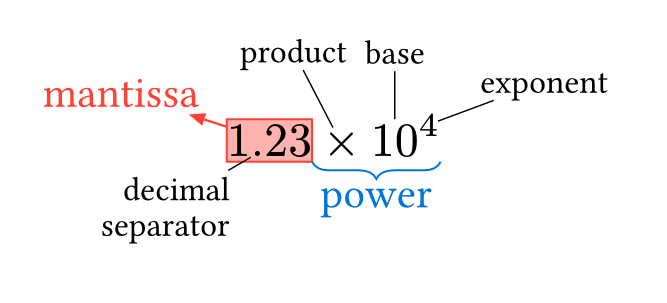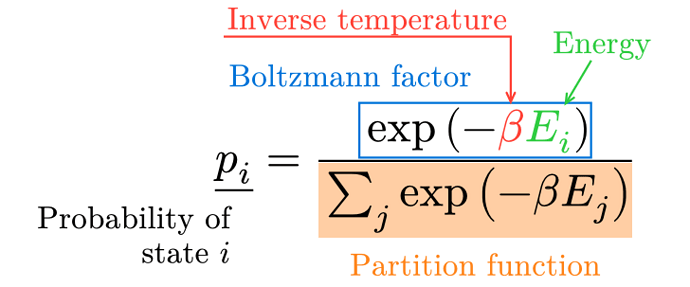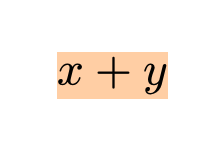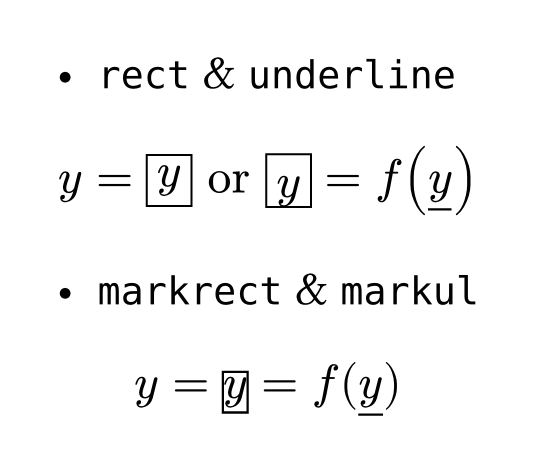Hey everyone!![]()
I’m excited to announce the release of mannot v0.3.0, the Typst package for marking and annotating elements within your math blocks!
This new version brings some exciting changes and improvements:
![]() Flexible Leader Lines: The
Flexible Leader Lines: The annot function now supports direct, straight leader lines (in addition to elbow-shaped ones). Also, you can customize your arrowheads using tiptoe package.
![]() CeTZ Annotations: Unleash the power of graphical annotations with CeTZ canvas support using the new
CeTZ Annotations: Unleash the power of graphical annotations with CeTZ canvas support using the new annot-cetz function.
Your feedback is always appreciated!
Links
- Github: GitHub - ryuryu-ymj/mannot: A package for marking and annotating in math blocks in Typst.
- Universe: mannot – Typst Universe
Examples
#import "@preview/mannot:0.3.0": *
#set page(width: auto, height: auto, margin: (left: 4cm, top: 2cm, rest: 1cm), fill: white)
#set text(24pt)
$
markul(p_i, tag: #<p>) = markrect(
exp(- mark(beta, tag: #<beta>, color: #red) mark(E_i, tag: #<E>, color: #green)),
tag: #<Boltzmann>, color: #blue,
) / markhl(sum_j exp(- beta E_j), tag: #<Z>)
#annot(<p>, pos: bottom + left)[Probability of \ state $i$]
#annot(<beta>, pos: top + left, dy: -1.5em, leader-connect: "elbow")[Inverse temperature]
#annot(<E>, pos: top + right, dy: -1em)[Energy]
#annot(<Boltzmann>, pos: top + left)[Boltzmann factor]
#annot(<Z>)[Partition function]
$
#import "@preview/mannot:0.3.0": *
#import "@preview/cetz:0.3.4"
#set page(width: auto, height: auto, margin: (y: 2cm, bottom: 1cm), fill: white)
#set text(size: 24pt, fill: black)
#let rmark = mark.with(color: red)
#let bmark = mark.with(color: blue)
#let pmark = mark.with(color: purple)
$
( rmark(a x, tag: #<ax>) + bmark(b, tag: #<b>) )
( rmark(c x, tag: #<cx>) + bmark(d, tag: #<d>) )
= rmark(a c x^2) + pmark((a d + b c) x) + bmark(b d)
$
#annot-cetz(
(<ax>, <b>, <cx>, <d>),
cetz,
{
import cetz.draw: *
set-style(mark: (end: "straight"))
bezier-through("ax.south", (rel: (x: 1, y: -.5)), "cx.south", stroke: red)
bezier-through("ax.south", (rel: (x: 1, y: -1)), "d.south", stroke: purple)
bezier-through("b.north", (rel: (x: .6, y: .5)), "cx.north", stroke: purple)
bezier-through("b.north", (rel: (x: .6, y: 1)), "d.north", stroke: blue)
},
)
#import "@preview/mannot:0.3.0": *
#import "@preview/cetz:0.3.4"
#set page(width: auto, height: auto, margin: (x: 4cm, top: 2cm, bottom: 1cm), fill: white)
#set text(size: 24pt, fill: black)
#let markhl = markhl.with(stroke: 1pt)
$
markhl(1 mark(., tag: #<sep>) 23, tag: #<mantissa>, color: #red)
mark(
mark(times, tag: #<prd>)
mark(10, tag: #<base>)^mark(4, tag: #<exp>),
tag: #<pow>,
)
$
#{
let annot = annot.with(leader-tip: tiptoe.triangle, leader-toe: none)
annot(<mantissa>, pos: left, dx: -.5em, dy: -1em, annot-text-props: (size: .9em))[mantissa]
let annot = annot.with(leader-stroke: .03em, leader-tip: none, leader-toe: none)
annot(<sep>, pos: bottom + left, dx: -.5em)[decimal \ separator]
annot(<prd>, pos: top, dx: -1em, dy: -1.2em)[product]
annot(<base>, pos: top, dy: -1em)[base]
annot(<exp>, pos: top + right, dx: 1em)[exponent]
annot-cetz(
<pow>,
cetz,
{
import cetz.draw: *
cetz.decorations.flat-brace(
"pow.south-west",
"pow.south-east",
flip: true,
name: "brace",
stroke: blue,
)
content("brace.south", anchor: "north", text(blue, .9em)[power])
},
)
}




